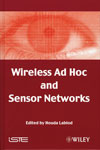Wireless Ad Hoc and Sensor Networks
Houda Labiod, Editor
329 pages; $165 • John Wiley & Sons Inc.
ISBN: 978-1-84821-003-5
 Wireless local area networks were designed as data transmission systems to wirelessly connect computer peripherals, independent of their location. They now appear to be a key component in a centralized architecture integrating wireless and mobile technologies. Two other adjacent domains have quickly appeared: first mobile ad hoc networks (MANETs) and more recently sensor networks.
Wireless local area networks were designed as data transmission systems to wirelessly connect computer peripherals, independent of their location. They now appear to be a key component in a centralized architecture integrating wireless and mobile technologies. Two other adjacent domains have quickly appeared: first mobile ad hoc networks (MANETs) and more recently sensor networks.
After an introduction in Chapter 1, Chapter 2 presents a detailed description of the concepts and principles used in MANETs. It focuses on work related to unicast ad hoc routing, which is a critical basic function that any ad hoc network must support. Ad hoc networks are completely infrastructureless; their changing topology and limited resources raise the problem of quality of service support at different levels (access support, signaling, etc.) even more so because of greater complexity. These constrains are explained in Chapter 3. Because of its importance for grouped communications, multicast routing has the capability to optimize resource usage and therefore conserves bandwidth, which is covered in Chapter 4.
Chapter 5 discusses a critical problem for autonomous networks (ad hoc or sensors networks): self organization. Chapter 6 is dedicated to the discovery and emergence of services, while Chapter 7 focuses on protocol aspects when merging services discovery with routing in ad hoc mobile networks. Chapter 8 presents a state-of-the-art on the different clustering techniques developed for ad hoc networks, including two (or more) hop clusters. Routing and data transmission security in ad hoc networks are discussed in Chapter 9, and Chapter 10 discusses distributed algorithms in large scale systems. Code mobility in sensor networks is addressed in Chapter 11, and Chapter 12 discusses specific ad hoc networks called vehicle-to-vehicle communications or VANET.
To order this book, contact:
John Wiley & Sons Inc.
One Wiley Drive
Hoboken, NJ 08875
(800) CALL WILEY
Ubiquitous Positioning
Robin Mannings
210 pages; $69, £37 • Artech House
ISBN: 978-1-59693-103-9
 This groundbreaking resource offers a practical, in-depth understanding of ubiquitous positioning (called Whereness by the author)—a technology that identifies the location and position of people, vehicles and objects in time and space in the digitized networked economy.
This groundbreaking resource offers a practical, in-depth understanding of ubiquitous positioning (called Whereness by the author)—a technology that identifies the location and position of people, vehicles and objects in time and space in the digitized networked economy.
The future and growth of ubiquitous positioning will be fueled by the convergence of many other areas of technology, from mobile telematics, Internet technology and location systems, to sensing systems, geographic information systems and the semantic web. Chapter 1 starts with some history, background and terminology, and then continues with some general principles. Chapter 2 is an overview of Whereness that follows the structure of later chapters. Chapters 3 to 5 concern the motivation for Whereness and are aimed at providing a commercial view of why anyone would want to pay for it. Chapter 3 takes a broad view of all commercially important issues, discussing Whereness within the digital networked economy.
Chapter 4 focuses on specific applications relevant to current businesses. Chapter 5 is more futuristic and starts with a discussion of societal changes and the important part Whereness could have in the future. Chapter 6 is concerned with radio technology, covering global navigational systems (GNSS), which includes GPS, cellular radio, WiFi and Radio Frequency Identification (RFID). Chapter 7 covers the non-radio techniques to find position. Some are wireless, such as optical and ultrasonic systems and others are mechanical, including mobile inertial systems and active flooring. Web 2.0 is discussed in detail in Chapter 8 covering maps, mapping and geographic information systems (GIS). The concluding chapter continues with technology, but it concerns the future and has a strong research flavor.
To order this book, contact:
Artech House
685 Canton St.
Norwood, MA 02062
(781) 769-9750 ext. 4030; or
46 Gillingham St.
London SW1V 1HH, UK
+44 (0) 207-8750
